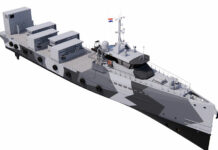 The Navy is proposing a change in its plan to acquire a new class of warship called the Littoral Combat Ship. Until this week, the plan of record was to select a winning design from one of two competing teams, with the victorious team producing ten ships and then another source being selected in 2012 to produce five more. Now the Navy says it wants each of the two competing teams to build ten ships based on their very different designs, so it can accelerate purchase of the new class while maintaining competition during the production phase. It plans eventually to buy 55 Littoral Combat Ships for conducting shallow-water missions such as antisubmarine warfare currently performed by frigates.
The Navy is proposing a change in its plan to acquire a new class of warship called the Littoral Combat Ship. Until this week, the plan of record was to select a winning design from one of two competing teams, with the victorious team producing ten ships and then another source being selected in 2012 to produce five more. Now the Navy says it wants each of the two competing teams to build ten ships based on their very different designs, so it can accelerate purchase of the new class while maintaining competition during the production phase. It plans eventually to buy 55 Littoral Combat Ships for conducting shallow-water missions such as antisubmarine warfare currently performed by frigates.
If you examine the production profile for the revised shipbuilding strategy, it isn’t all that different from the previous plan. Under the old plan, the service would have bought four warships based on the winning design each year after 2012 — two from the lead shipyard, two from a second source. Under the new plan it will be buying the same number of ships each year from the same number of sources, but there will be two different designs. The “new” approach is actually what the Navy was considering doing a few years ago, until the high cost of initial ships in the class convinced planners they would need to economize by selecting a single design. The designs were so different — one was a steel monohull, the other an aluminum trimaran — that each seemed like it might be better suited to particular warfighting scenarios.
Now the Navy says that price reductions offered by contractors as they learn more about how to produce their respective designs have enabled the service to buy both types. That may increase the cost of maintaining the Littoral Combat Ship fleet at sea — economies of scale will be lost — but it also maximizes the operational versatility of the fleet. Once there is more experience with both designs, the service can make an informed decision about what mix of ships would be optimum. But if the new approach is such a smart idea, then doesn’t that bolster the case for a split buy of other military systems, like fighter engines or aerial refueling tankers?
Here’s why it doesn’t. The military marketplace isn’t like other markets. There’s only one customer — the government — so that one customer has to pay all the costs of creating and sustaining competing military suppliers. In the case of General Electric’s proposed “alternate engine” for the F-35 fighter, both the Bush and Obama Administrations decided there was no guarantee the government could ever recoup the billions of dollars required to qualify a second engine supplier. Competition might reduce some costs and enhance some performance features, but not enough to cover the bill for supporting two production lines, two supplier bases, and two maintenance systems. That’s why the government doesn’t compete any other item on the F-35, or compete the engines on its bombers and cargo planes.
The late Congressman Jack Murtha proposed splitting the buy of future aerial refueling tankers as a way of ending the political impasse over tanker modernization. But the problem with a split buy of tankers was that the government only had enough money to buy 15 tankers per year, and each of the competitors was offering a modified airliner for which commercial demand was likely to disappear in the future. The government thus would have ended up as the sole customer for two different production lines, each of which would have produced a handful of planes each year at astronomical prices. The high price of the planes would have slowed the pace of tanker modernization at a time when planners were worried about the safety of continuing to operate 50-year-old tankers. So in the case of fighter engines and tankers, splitting production is likely to hurt warfighters and taxpayers, not help them. Apparently the situation is different with the Littoral Combat Ship.
This news analysis written by Loren B. Thompson, Ph.D. was first published by the Lexingon Institute, November 4, 2010.



















